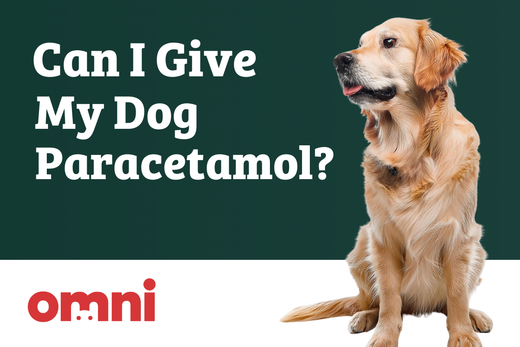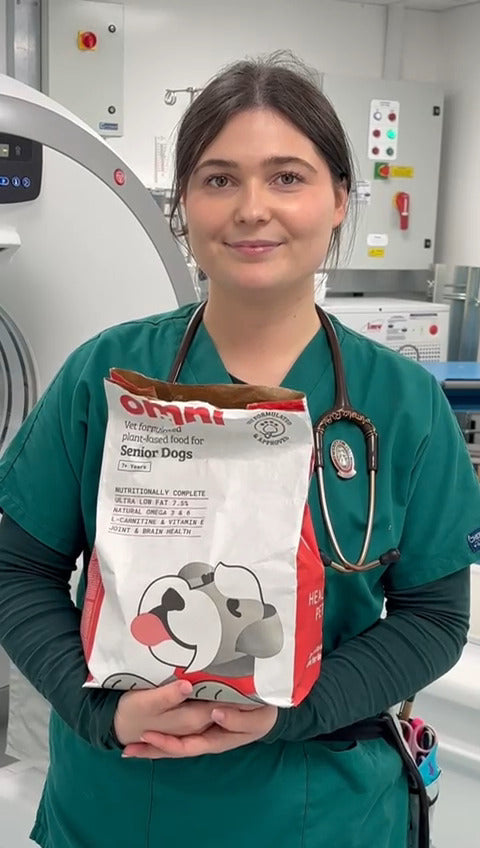Can I Give My Dog Paracetamol? | Ask a Vet | Omni.pet

Can I Give My Dog Paracetamol?
As pet owners, it’s natural to want to relieve your dog’s pain when they seem uncomfortable. One common question we get is, “Can I give my dog paracetamol?”
While paracetamol (also known as acetaminophen) is a household medication for humans, its use in dogs is much more complex and requires veterinary supervision.
In this article, our Chief Veterinarian and Omni Co-Founder, Dr. Guy MRCVS, explores the risks and recommendations surrounding the use of paracetamol for dogs.
Can Dogs Have Paracetamol?
Yes, but strictly only under the advice of a vet.
As of a recent update to UK law, it is now illegal for vets to promote or facilitate illegal off-licence use of medicines in animals without justification.
Do not give your dog paracetamol without having first consulted a veterinarian.
Paracetamol can be effective for managing pain in dogs, but it is only ever used as a last line of defence and may cause side-effects in your dog.
Vets are legally bound to prescribe medications specifically designed for pets, such as non-steroidal anti-inflammatory drugs (NSAIDs) like meloxicam or carprofen, which are safer and more suitable for managing pain and inflammation in dogs.
Why Paracetamol Is Not the Best First Option
- Better alternatives are available: Veterinary NSAIDs are tailored to a dog’s metabolism and offer safer, more reliable pain relief for a range of conditions, from arthritis to post-surgical discomfort.
- Limited use cases: Paracetamol is only ever recommended for very specific conditions and at specific dosages that your vet will determine based on your dog’s size, age, and pre-existing health conditions.
Risks of Giving Paracetamol to Dogs
Giving paracetamol without veterinary supervision can lead to serious health risks for your dog.
Toxicity and Organ Damage
- Liver damage: One of the primary concerns with paracetamol in dogs is its potential to cause liver toxicity. Even a slight overdose can lead to irreversible liver damage for your dog.
- Other organ issues: Paracetamol may also affect other organs, particularly the kidneys, which can be fatal if not treated promptly.
In fact, a study published in Companion Animal highlights how dogs metabolise paracetamol differently from humans, making them more susceptible to overdose and organ damage.
Is Paracetamol Ever Safe for Dogs?
While paracetamol may have a place in certain treatment plans, it is an "off-licence" medication for dogs, meaning it has not been approved specifically for canine use. A vet can only prescribe it when there is a justified medical reason, and the dosage must be precise.
In addition, if there is any other option outside of paracetamol, then the vet may face criminal charges for prescribing paracetamol. It is therefore highly unlikely that you will ever find a vet prescribing paracetamol to your dog.
This is due to prescription guidelines explained in a decision-making model known as 'the Cascade'.
When Vets Might Prescribe Paracetamol:
- Special conditions: In rare cases, a vet might recommend paracetamol if other pain relief options are not suitable, for example, if a dog has an intolerance to NSAIDs or other medications.
- Precise dosing: Only a vet can determine the correct dosage, which is often much lower than what humans take. Never attempt to give your dog paracetamol without professional guidance.
How to Safely Manage Your Dog's Pain
If you suspect your dog is in pain, always consult a vet first. They will be able to assess the situation and recommend the most appropriate treatment plan. Common alternatives to paracetamol include:
- NSAIDs: These are typically safer for managing pain and inflammation in dogs.
- Joint supplements: For chronic conditions like arthritis, supplements such as glucosamine and omega-3 fatty acids can help reduce inflammation and pain over time.
- Prescription pain relief: Your vet might prescribe medications that are specifically designed for dogs, ensuring effective and safe treatment.
Speak with a Vet If…
- You are unsure about your dog’s symptoms or the appropriate course of action.
- Your dog has pre-existing conditions like liver or kidney disease, which could increase the risk of complications.
- You need advice on pain management and suitable alternatives to paracetamol.
Book a free consultation with Omni’s veterinary team to get expert advice on your dog’s health and pain management strategies. Never self-medicate your dog with human medications without professional guidance.
Thoughts from Dr Guy MRCVS
As dog lovers and guardians, it’s natural to worry about our furry friends, especially when they display abnormal symptoms that can’t be easily explained. That’s why, when I founded Omni, I knew that I wanted to keep vet consultation free and accessible at the heart of the business.
If you’re understandably worried about your dog, but you don’t think you need to take them to the vets urgently, I highly recommend getting some friendly, professional advice from one of our team.
Disclaimer: This article provides general advice and should not replace direct veterinary care. Always consult a vet before administering any medication to your dog.







 85 Great Portland Street, 1st Floor, London, W1W 7LT United Kingdom
85 Great Portland Street, 1st Floor, London, W1W 7LT United Kingdom